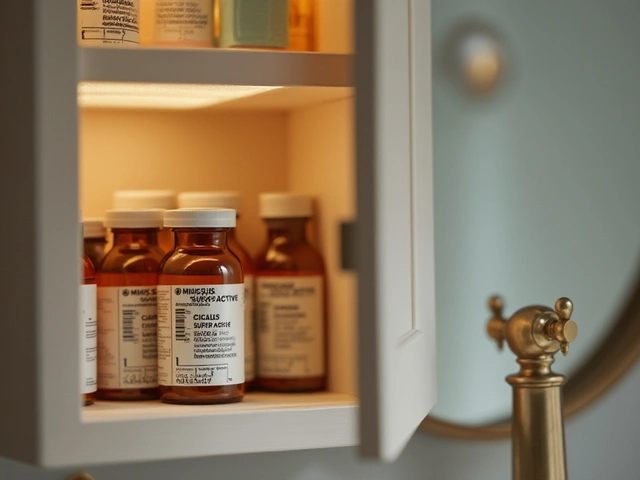 2
Feb,2025
2
Feb,2025
Managing asthma or COPD is a balancing act, requiring the right inhaler to keep symptoms at bay. Symbicort is a staple in treating these conditions but might not be the perfect fit for everyone. Whether you're looking for a cost-effective option or stumbling upon availability issues, exploring alternatives is a wise move. Throughout this article, we'll delve into different inhalers that offer a similar relief and how they stack up against Symbicort. Let's get started!
Breyna
When it comes to finding an alternative to Symbicort, one name that often comes up is Breyna. This inhaler is a budesonide/formoterol combination, similar in many ways to Symbicort, making it a viable option for those needing a replacement or something potentially more cost-effective.
Breyna offers identical active ingredients, which means it works on the same principle as Symbicort—tackling both the inflammatory and bronchoconstrictive aspects of asthma or COPD. This makes it a trusted option for those who have found good results with Symbicort but are exploring other avenues.
Pros of Breyna
- Identical active ingredients: Featuring the same medication combination found in Symbicort, users can expect similar efficacy in controlling asthma and COPD symptoms.
- Potentially lower cost: Breyna may come with a more accessible price tag, making it an attractive choice for those paying out of pocket or with specific insurance plans.
Cons of Breyna
- Less common brand name: Breyna might not be as well-known or widely discussed among healthcare professionals or patients, which could impact perceived trust.
- Availability may vary: Depending on your region or pharmacy, Breyna's availability may not be as reliable as Symbicort, potentially complicating prescription needs.
Despite these drawbacks, Breyna remains a compelling alternative, offering familiar relief with potential benefits in cost and formulation. Patients considering Breyna should consult their healthcare providers to ensure it suits their individual health needs and circumstances.

Conclusion
Exploring alternatives to Symbicort opens a world of options for those managing asthma and COPD. Each alternative has its own merits and drawbacks, fitting the varied needs of individuals who may seek a change due to cost, availability, or personal health requirements. These alternatives ensure that effective asthma treatment is accessible to a wider audience, embodying the ethos of personalized healthcare.
Let's take a more holistic view with a quick comparison that encapsulates the essential qualities of Symbicort and its main alternative, Breyna:
| Alternative | Active Ingredients | Pros | Cons |
|---|---|---|---|
| Breyna | Budesonide/Formoterol | Identical active ingredients to Symbicort, potentially lower cost. | Less common brand name, availability may vary. |
The potential of Breyna as a cost-effective option with similar active ingredients to Symbicort reflects the ongoing commitment within the healthcare industry to foster competitive pricing and accessibility. However, as Breyna's availability depends on market factors, patients often find value in maintaining flexibility and open communication with their healthcare providers to ensure that any transition to a new medication is seamless and effective.
For patients motivated by financial considerations or encountering issues with Symbicort's availability, these alternatives provide viable options. Discussing these alternatives with your healthcare provider ensures that the journey towards optimal respiratory health is as smooth and effective as possible. Remember, your wellbeing always deserves a tailored approach.






Great overview of the therapeutic landscape! The article rightly highlights budesonide/formoterol as a cornerstone inhaled corticosteroid‑LABA combo, which aligns with current GOLD and GINA recommendations. For clinicians seeking cost‑effective alternatives, the pharmacokinetic equivalence is a key consideration. Moreover, the discussion about insurance formularies adds a practical dimension that many patients overlook. Overall, this piece provides a solid foundation for shared decision‑making.
The Breyna hype seems overstated given the identical pharmacodynamics.
When we contemplate the ontology of inhaled therapy, we must first acknowledge the inherent duality of formoterol's rapid onset and budesonide's anti‑inflammatory grace. This dichotomy mirrors the ancient philosophical debate between immediacy and patience, a tension that resonates deeply within the pulmonary sphere. Yet, Breyna, despite its nominal novelty, merely recasts this age‑old synergy under a fresh brand veneer. One could argue that the novelty is a superficial ornament, akin to dressing a timeless theorem in avant‑garde garb. The patient, however, may perceive this rebranding as a promise of enhanced efficacy, though the molecular choreography remains unchanged. In the grand tapestry of therapeutic options, Breyna threads a familiar pattern, woven with identical molecular yarns. Its cost reduction, while tempting, must be weighed against the intangible value of brand familiarity and prescriber confidence. The literature, albeit sparse, hints at comparable outcomes, yet the paucity of long‑term real‑world data invites caution. Imagine a scenario where a physician, swayed by formulary constraints, pivots to Breyna; the subsequent adherence hinges not only on pharmacology but also on patient perception. Thus, the discourse transcends mere chemistry, entering the realm of psychology and health economics. Ultimately, the decision matrix is multidimensional, demanding that we scrutinize both the quantitative efficacy and the qualitative patient experience. In sum, Breyna stands as a testament to the perpetual dance between innovation and tradition in respiratory care.
Hey folks, just wanted to throw some positive vibes into the mix! If cost is the main hurdle, Breyna could be a pragmatic bridge while you keep the treatment goals steady. Remember, consistency in inhaler technique often matters more than the brand name itself. Stay motivated, keep those rescue inhalers on standby, and don’t hesitate to discuss formulary swaps with your provider.
While the article is informative, it omits several pivotal considerations; for instance, the bioequivalence studies, which are essential, are only briefly mentioned. Moreover, the discussion fails to address the potential variance in particle size distribution, a factor that can influence deposition in the lower airways. In future revisions, please incorporate a comprehensive tabular comparison, including those pharmacokinetic nuances.
Honestly, i think the whole breyna thing is just a marketing gimmick. sure, it has the same actives but who knows if the inhaler device works as well? maybe its just a ploy to push cheaper meds thru insurance.
Don't be fooled – cheaper doesn't always mean better, especially when the device reliability is questionable.
Dear readers, it is both encouraging and reassuring to observe the concerted efforts toward expanding therapeutic accessibility. The introduction of Breyna exemplifies a commendable stride in aligning clinical efficacy with economic prudence. I applaud healthcare stakeholders for facilitating such alternatives, which undoubtedly serve the broader populace. May this momentum continue, fostering an environment where optimal respiratory health is attainable for all.
yeah, looks like a solid option. just hope the pharmacies actually stock it, otherwise all the talk is moot. kinda cool they're trying to keep prices down.
The article glosses over the emotional toll of switching inhalers; patients often feel abandoned when their familiar device disappears. This oversight feels callous.
While I respect the intention to inform, the piece could benefit from a more balanced appraisal of patient sentiment. Not everyone finds brand changes seamless.
I think it's great that the community is sharing alternatives. Collaboration helps us all navigate insurance hurdles and find what works best for individual needs.
Absolutely, staying open to options while keeping the conversation respectful ensures everyone feels heard.
The discussion about Breyna is useful, yet it would be helpful to see head‑to‑head clinical outcomes compared to Symbicort. Also, a brief note on inhaler technique variations could aid patients transitioning between devices. Overall, a solid starter, but more data would solidify confidence.
Philosophically speaking, the search for a 'best' inhaler mirrors humanity's quest for the ultimate truth-always out of reach, forever debated.
Interesting point, Joseph. If I may add, ensuring patients understand the correct actuation technique could mitigate any perceived efficacy gaps between brands. Perhaps a short instructional graphic could complement the article? Looking forward to more evidence‑based comparisons.
Let's dissect the grammar of that last paragraph, shall we? Firstly, "If I may add" should be followed by a comma-yes, a comma! Secondly, the phrase "could mitigate any perceived efficacy gaps" is perfectly acceptable, but the verb tense could be tightened for clarity; consider "might mitigate" instead.
Beyond punctuation, the sentence "Perhaps a short instructional graphic could complement the article?" ends with a question mark, yet it's a suggestion rather than a query-perhaps a period would serve better. Finally, watch out for dangling modifiers; "Looking forward to more evidence‑based comparisons" is fine, but ensure it directly follows a subject to avoid ambiguity. In sum, the content is valuable, but polishing these linguistic details will elevate the professionalism of the piece. Keep up the good work, and don't forget the Oxford comma where appropriate.